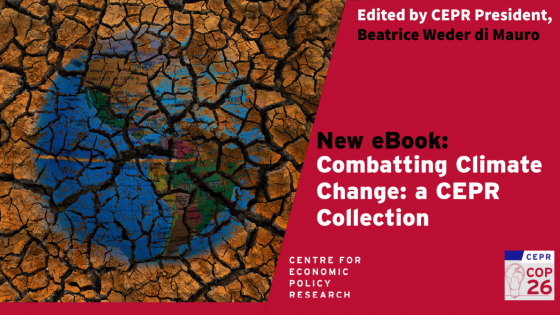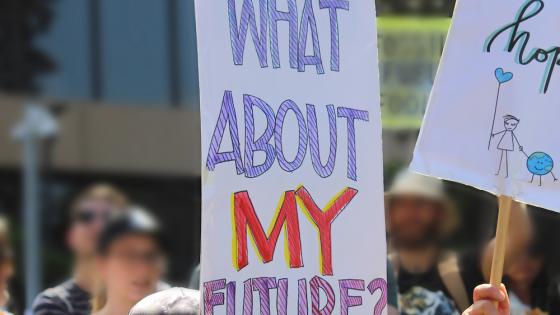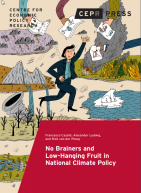Surely there can be hardly anyone left who truly doubts that climate change is real and that it is here. The recent experiences of severe weather events – floods, fires, droughts, and storms – visibly drive home what scientists have been saying for years: global warming threatens life on a planetary scale; it is man-made, predictable and, although not reversible, its further escalation is mitigable.
Today, it is rare to have conversations of the ‘but there was always climate change, and who says that this time is different’ type. Instead, both public and private actors seem to be aggressively embracing the fight against climate change. Rare indeed, these days, is the financial institution that does not promote its environmental, social, and governance (ESG) credentials. At the time of writing, world leaders are meeting for the COP26 Conference in Glasgow and expectations are simultaneously high and low. There are high expectations for some further progress but low expectations of sufficient progress towards the goal of limiting global warming to 1.5°C.
Submerged beneath the flood of information, initiatives, ideas, and pronouncements, it is hard to keep sight of what is needed for this goal. It is easy to get lost, primarily because the science of climate change is complicated, requires very long-run forecasts, and involves large confidence intervals. The same is true of the economics of climate change: separating the signal from the noise, filtering out the quality research is hard.
Research published by CEPR and VoxEU has served this purpose for years: it filters and disseminates the economic research you ought to read.
A new CEPR eBook brings together 45 Vox columns on the economics of climate change, mostly published over the past 2–3 years (Weder di Mauro 2021). The sheer quantity is testimony to the acceleration of research, knowledge, and interest in the economics profession. I had to limit the number of columns chosen and to exclude many interesting pieces from this collection. The cut-off date was beginning of October 2021 and my selection bias was for recent and solutions-oriented contributions. However, in a few cases I have included older pieces, those that trace some of the ‘history of thought’. Below, I highlight a few selected insights on the economics of climate change as illustrated in this collection, but first I want to focus on the science of climate change.
Download Combatting Climate Change: A CEPR Collection here.
Science first: Some numbers worth remembering
To keep eyes on the goal, a few numbers from the latest report of the IPCC are extremely helpful.1 The numbers are: 40, 300 and 2,390. Forty gigatonnes represents the current yearly emissions of CO2 at the global level, 300 gigatonnes is the remaining carbon budget of global emissions, if the 1.5°C is to be reached with high (more than 80%) likelihood, and 2,390 gigatonnes of CO2 is the estimate of cumulative historical emissions since 1850 already in the atmosphere.2 These are sobering numbers for several reasons.
First, the 2,390 gigatonnes shows the size of the historical burden. Past emissions mean that the world has already almost exhausted the total carbon budget to limit global warming to 1.5°C. These emissions will remain in the atmosphere for hundreds of years to come and have already warmed the earth by about 1°C (over preindustrial levels). It is noteworthy that this historical burden was accumulated almost exclusively by high-income countries.
Second, the 300 gigatonnes remaining budget is sobering because it is absolute. This is all that remains, full stop. This is how much this and any future generations have left if warming is to be limited to no more than 1.5°C. At the current rate of 40 gigatonnes per year, the world has about eight years left. To my mind, this simple fact is such a powerful illustration of the challenge: the famous race to net zero needs a fast start if we are to limit global warming to 1.5°C.
Were the world to give up on the 1.5°C target and set the limit to 1.7°C or 2°C, the remaining carbon budgets would amount to 550 and 900 gigatonnes, respectively. This would allow a bit more time to get to net zero, as illustrated in Figure 1, but it does little to reduce the urgency to act and the environmental costs of any further delays.
Figure 1
Source: Author[s] calculations based on Table SPM.2 . IPCC Climate Change 21, The Physical Science Base,
If we were to translate the remaining budgets into minutes until midnight, the clock would say that it is 7 minutes to midnight for 1.5°C, 11 minutes to midnight for 1.7°C, and 16 minutes to a midnight of 2°C warming. It is worth noting that although the relationship between emissions and warming seems to be near linear, the consequences of higher temperatures are not. Another way of looking at these numbers is to conclude that we need to develop carbon extraction technologies very fast and at scale. Unfortunately, this technology does not seem to be ‘just around the corner’.
Is the economics profession rising to the challenge?
Given the size of the challenge, what are economists doing? Not much, according to Andrew Oswald and Nicolas Stern (Chapter 1). They look at the number of papers on climate change published in top economics journals and conclude that the economics profession has been failing the world. According to their count, the Quarterly Journal of Economics (QJE), for instance, had not published even one article on the economics of climate change until 2019 (a quick Google search for climate and QJE suggests that this may be unchanged, although it does reveal one QJE article published in 1917 on climate change as an element in the fall of Rome).
Not all economists can be accused of staying silent on the issue. Some of the most prominent economists were working on solutions years ago, as shown in Section I of the book. In several VoxEU columns from 2007-2009 (Chapters 2–7), Nicolas Stern, Geoffrey Heal, Jean Tirole, Michael Spence, Jeffrey Frankel and Philippe Aghion (with Reinhilde Veugelers and David Hemous) engage with and put forward proposals on how to achieve a global deal. These pieces are worth re-reading for the historical record but also because some of issues they raise remain relevant today.
I will not summarise all chapters in this part, but there are some results that bear highlighting:
- Optimal carbon pricing has attracted most attention from economists for decades. But one takeaway from the chapters collected under this heading is that since the Paris agreement of 2015, the debate has moved from a Pigouvian internalisation approach to carbon pricing (i.e. estimating the present value of the flow of marginal damages of one tonne of CO2) to a maximum quantity approach (i.e. estimating the optimal dynamic path for the shadow carbon price compatible with a fixed remaining carbon budget).
- From an economics perspective, a high initial price of carbon with a low growth rate of price increase may be optimal (as suggested by Collier), but this may not be politically palatable. With high carbon prices, a mechanism to deal with carbon leakage and designing appropriate carbon border adjustment mechanisms becomes essential (as proposed by the Franco-German Council of economic experts) .
- Calls to harness green finance for climate-related investment are everywhere and the financial industry seems to be embracing ESG finance whole-heartedly, but the evidence from the columns on the impact of green finance is mixed. There is some evidence of impact on stock prices, bank lending conditions, and bank credit flows, but no overwhelming evidence that this is moving the needle.
- Measuring ESG criteria is a jungle – virtually hundreds of metrics, ratings, and standard setters are competing. Regulators have been trying to catch up by designing taxonomies and setting standards, which are themselves very complex. What is missing is a simple measure of carbon emissions in tonnes of CO2. The carbon budget in tonnes is absolute and limited, so tonnes are what matters, not carbon footprints relative to sales, assets, or competitors. Disclosing the absolute amount of CO2 emissions (scope 1) should be mandatory for every firm, as called for by Bolton et al.
- Harnessing green monetary policy has been more controversial. But some of the same arguments made for pricing climate risk in financial intermediaries’ balance sheets also apply for the portfolios of central banks. ‘Market neutrality’ is not a good benchmark for the allocation of central banks purchases since it cements the brown bias of today’s market shares.
- Global personal carbon inequality, as measured by Chancel and Piketty, shows that, “the top 1% richest Americans, Luxemburgers, Singaporeans, and Saudi Arabians are the highest individual emitters in the world, with annual per capita emissions above 200tCO2e. At the other end of the pyramid of emitters lie the lowest income groups of Honduras, Mozambique, Rwanda and Malawi, with emissions 2,000 times lower, at around 0.1tCO2e per person per year ”, and suggests that progressive levies be targeted at the individual top emitters to fund climate adaptation.
- The losers from climate change are today’s poorest locations, as shown by Cruz and Rossi-Hansberg. In their baseline scenario, welfare may increase by as much as 15% in regions of Canada and Siberia, but areas in Central and South America, Central Africa, India, and Southeast Asia may suffer welfare losses of between 10% and 15%.
- Massive international flows of climate refugees are unlikely since a mostly internal decline in rural income may depress the options for emigration in extremely poor countries. Burzyński et al. estimate that climate change might displace between 210 and 320 million people, mostly within their own countries.
- Avinash Persaud points out that in “countries on the frontline in the war against climate change, there is a nasty nexus between climate change and debt.” He suggests breaking this climate–debt nexus by redistributing special drawing rights (SDRs) towards the most vulnerable, recapitalising regional development banks with unused SDRs, and incorporating lending clauses in official lending, which would automatically suspend debt service following a natural disaster.
- Klenert and Hepburn start from the observation that the preferred instrument of economists – namely, carbon pricing – is politically unpopular. They suggest that lump-sum dividends to citizens may make it more palatable. Furceri et al. also focus on the political economy of implementing policies to fight climate change when it is politically costly. To increase popular support, they suggest, among other things, ditching market-based emissions pricing, carbon taxing, and so on in favour of regulatory approaches. In my personal experience, this last conclusion seems to be widely shared among policymakers and non-economists.
Conclusion
The purpose of this collection of articles on climate change, plucked from the recent crop of CEPR/VoxEU material, is threefold. First, it is intended to provide an overview of some of the key issues in climate change from the economist’s perspective. Second, it aims to stimulate further research, since the answers to many key questions, in particular those on global distributional issues, are still wide open. Finally, it serves to demonstrate that CEPR is fully engaged with this central debate of our times, and that we will use the power of this network to promote excellent research and relevant policy. I take very seriously the warning from Nicholas Stern and Andrew Oswald (Chapter 1): “If we (economists) do not move quickly, we think the discipline will be judged harshly by the humans of the future – including by our own offspring”.
References
Weder di Mauro, B (2021), Combatting Climate Change: A CEPR Collection, CEPR Press.
Endnotes
1 IPCC Climate Change 21, The Physical Science Base
2 See Table SPM.2 . IPCC Climate Change 21, The Physical Science Base.




